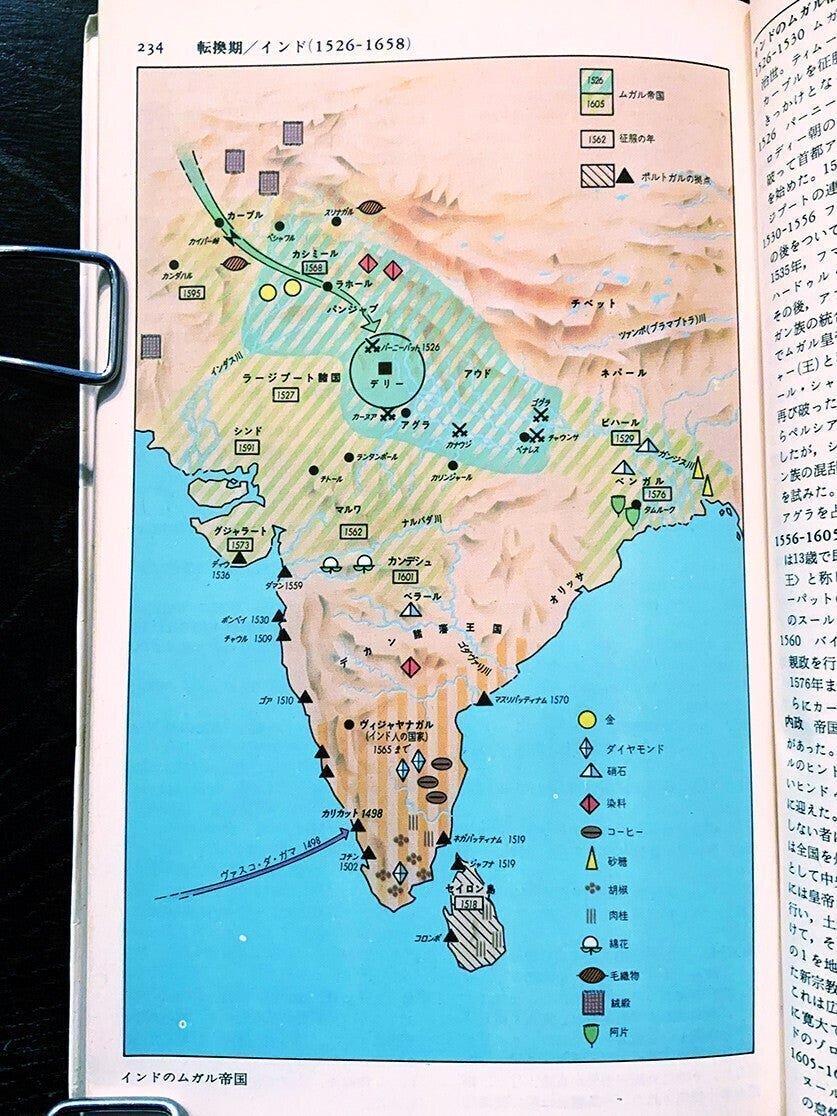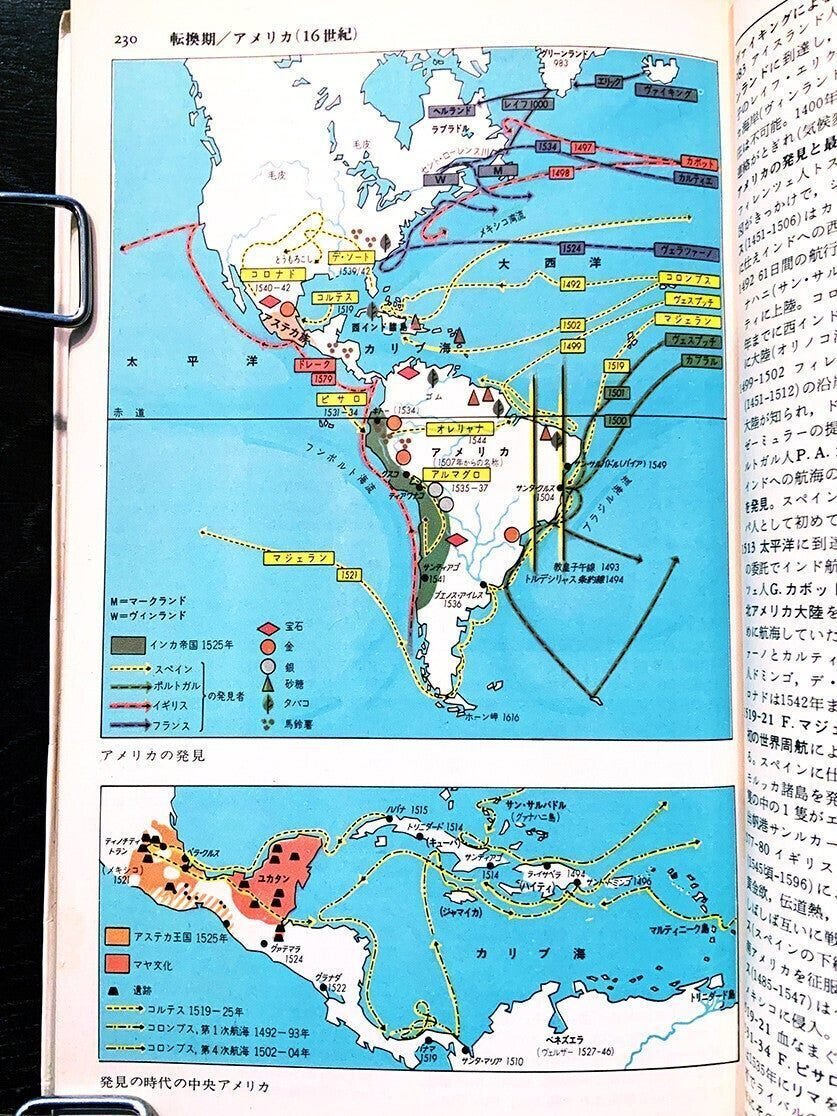
「日本」の英語呼称「Japan」マレー語移入説について考えてみた(承前の2)
英語「Japan」の元となった語がマレー語に由来する、という「ユール説」が、ヴィクトリア朝時代に編まれた英領インド帝國俗語事典『Hobson-Jobson』の「Japan」項に載っているのを、☟前回の記事で紹介した。
この事典は『Oxford English Dictionary』にアジア関係の語を載せる際、ジェームズ・オーガスタス・ヘンリー・マレー James Augustus Henry Murray が大いに参考になさったらしい。
今回はその続き、ヨーロッパの文献にあらわれる「日本」についての年代順記事リストを眺めるところからはじめるとしよう。
ヴィクトリア朝時代の本にある十三世紀「日本」の記述

☝マルコ・ポーロのアジア旅行路図。
1298. "Chipangu is an Island towards the east in the high seas 1,500 miles distant from the Continent; and a very great Island it is. The people are white, civilized, and well-favoured. They are Idolaters, and dependent on nobody...." — Marco Polo, bk. iii. ch. 2.
マルコ・ポーロの『世界の記述(いわゆる『東方見聞録』)』の一節の英訳。日本語訳は、成城大学紀要『Azul』第6号(2005年)に載った☟片山幹生「マルコ・ポーロ『世界の記述』における「ジパング」」の「II. 史実から伝説へ:「ジパング」の記述の背景」の p. 21 冒頭にある。
ヴィクトリア朝時代の本にある十六世紀「日本」の記述

☝ヴァスコ・ダ・ガマらの航海の軌跡。
ここで200年ばかり飛んだあと、日本についての記述の数がどっと増える。
1505. ".... and not far off they took a ship belonging to the King of Calichut; out of which they have brought me certain jewels of good value; including Mccccc. pearls worth 8,000 ducats; also three astrological instruments of silver, such as are not used by our astrologers, large and well-wrought, which I hold in the highest estimation. They say that the King of Calichut had set the said ship to an island called Saponin to obtain the said instruments..." — Letter from the K. of Portugal (Dom Manuel) to the K. of Castille (Ferdinand). Reprint by A. Burnell, 1881, p. 8.
「……そこからそう遠くないところで、カリカット王の船に乗り込んだ。彼らは船室の中から、8千ダカット相当の(「Mccccc.」がなんだかわからない……バーネルはおわかりだったのかしらん?)真珠を含む価値ある宝物を運び出してきた。それから、西洋の天文家が使ったことのない大きくて精巧な3つの銀製の天体観測器械——これがその宝の中でも最もすばらしいものだ——もあったが、これはカリカット王が「Saponin」という島に寄港した際に手に入れたものということだった……」ということかな?

これはヴァスコ・ダ・ガマ Vasco da Gama の2回目の遠征のときのことを、当時のポルトガル王マヌエル一世 Manuel I が、カスティリャ王国の(この前年に退位しているらしいのだが、おそらく)フェルナンド五世 Fernando V 宛てに送った書簡なのだろう。
東京外国語大学紀要『東京外国語大学論集』第39号(1989年)の☟金七紀男「マヌエル1世期 (1495-1521 年) におけるポルトガルの香料貿易 : マラバル地方の商館活動を中心に」の p. 241 第2章第2節に、このときのダ・ガマの活動のようすが書かれている。
それにしても、「日本」が「Saponin」って……どうしてこうなったwwww
というか、この島が本当に日本に比定されるのか、疑問を感じてしまう。

☝マジェラン(デ・マガリャンイス)らの航海の軌跡。
1521. "In going by this course we peased near two very rich islands; one is in twenty degrees latitude in the antarctic pole, and is called Cipanghu." — Pigafetta, Magellan's Voyage, Hak. Soc., 67.
Here the name appears to be taken from the chart or Mappe-Monde which was carried on the voyage. Cipanghu appears by that name on the globe of Martin Behaim (1492), but 20 degrees north, not south, of the equator.(引用者註:Hak. Soc.は「Hakluyt Society」版の意)
これはフェルディナンド・マジェランことフェルナン・デ・マガリャンイス Fernão de Magalhães の航海の話。同行したアントニオ・ピガフェッタ Antonio Pigafetta は赤道から20度南にいったところに「Cipanghu」という島がある、と書いているけれども、☟マルティン・ベハイムの地球儀だと赤道の北になっているよ、というご指摘。
1545. "Now as for us three Portugals, having nothing to sell, we employed our time either in fishing, hunting, or seeing the Temples of these Gentiles, which were very sumptuous and rich, whereinto the Bonzes, who are their priests, received us very courteously, for indeed it is the custome of those of Jappon (do Japão) to be exceeding kind and courteous." — Pinto, orig. cap. cxxxiv. (Cogan's E. T., p. 173).

☝覇権争いでがたがたする西ヨーロッパ。
「われわれ3人のポルトガル人は、今や取り引きしようにも何の売り物も手もとになく、釣りや狩りに出かけたり異国の寺院を見物にいったりすることに時を費やしていた。寺の建物はじつに豪華絢爛で、そこにいる僧侶たちは Japão 流のこの上もない懇切さと礼儀正しさをもって、非常に丁寧にわれわれを遇してくれた。」これはフェルナン・メンデス・ピント Fernão Mendes Pinto の 『ピント遍歴記 Peregrinação de Fernão Mendes Pinto』英語版☟『The voyages and adventures of Fernand Mendez Pinto.』の一節(字が小さいので、ちょっと見つけづらいかも……)。
これは、☟前々回取り上げた岡本良知「ジパングよりジャパンへの推移」
では p. 5〜6 に
また日本發見者の一人だといはれるフェルナン・メンデス・ピントの Peregrinação の中、その發見の一節にヤパン(Japão)といふ語が見える。併し、その著作のときが一五八〇年頃であつたから名稱としてはあまり重要でない。
というご指摘箇所と同じとおもわれるが、そうだとするとユールによればもっと早い時期の記述ということになる。
1553. "After leaving to the eastward the isles of the Lequios (see Loo Choo) and of the Japons (dos Japões), and the great province of Meaco, which for its great size we know not whether to call it Island or Continent, the coast of China still runs on, and those parts pass beyond the antipodes of the meridian of Lisbon." — Barros, I., ix. 1.(引用者註:今回の話題には直接かかわりないが、☟第二版では「(see Loo Choo)」は「(see LEW CHEW)」に変わっている)
これも☝岡本の論文 p. 4 に出てくる、前回引用したジョアン・デ・バロス João de Barros の☟『Da Asia De Joāo De Barros』第一部
の一節を英訳したもの。 p. 288 の真ん中辺に
Post què passemos ao Oriente della ás Ilhas dos Lequios, e dos Japões, e a grande Provincia Meacó, que ainda por sua grandeza não sabemos se he Ilha, se terra firme, continúa a outra costa da China, as quaes partes já passam por antipodas do meridiano de Lisboa.
とあるのがそれらしい。
つまりバロスとピントの記述は、岡本説とは順番が逆ということになる。
そういえば、日本で最期を迎えられたルイス・フロイス Luís Fróis の☟『Historia de Japam(日本史)』も、だいたいこの辺の時期にあたる。
次のは、著名ポルトガル詩人、ルイス・ヴァス・デ・カモンイス Luís Vaz de Camões 『OS LUSIADAS』第一巻に載っている作品第百三十一篇の後半と、リチャード・フランシス・バートン Richard Francis Burton によるその英訳。
1572.
"Esta meia escondida, que responde
De longe a China, donde vem buscar-se,
He Japão, onde nasce la prata fina,
Que illustrada será co'a Lei divina."
Camões, x. 131.
By Burton:
"This Realm half-shadowed, China's empery
afar reflecting, whither ships are bound,
is the Japan, whose virgin silver mine
shall shine still sheenier with the Law Divine."
(引用者註:バートン訳1行目は、第二版では「This Realm, half-shadowed, 」となっているが、☟1880年版をみるとカンマはない。そして「sheen'ier」のアポストロフィは、どちらの版でももれているようだ)
『HOBSON-JOBSON』に載っていない十六世紀「日本」の記述
順番からいくと、この次に☟前々回取り上げた1577年のリチャード・ウィリス Richard Wylles 「Of the Ilande Giapan, and other litle Isles in the East Ocean」
がくるはずだが、ユールは『The History of Trauayle in the VVest and East Indies』をご覧になる機会がなかったらしく、ここには出てこない。

☝「東西インド」のお宝を積んだ先発組の商船航路を、後発組の海軍兼海賊が襲うの図。
ついでにいうと、昭和十二年(1937年)日本英文學會『英文學硏󠄀究』第十七卷第三に載った☟岩崎克巳「日英人最初の接觸に就いて」という論文
に、フランシス・プリティ Francis Pretty 『The admirable and prosperous voyage of the Worshipfull Master Thomas Candish of Trimley in the Countie of Suffolke Esquire, into the South sea, and from thence round about the circumference of the whole earth, begun in the yeere of our Lord 1586, and finished 1588.』という(やたらと長いタイトルのついた)大英帝國の海賊トーマス・キャンディッシュ Thomas Candish の航海記のことを取り上げておられるのだが、天正十四年にあたる1586年の記事中に日本生まれの人物が出てくるという。
私にとつて最も興味深いのは Santa Ana の拿捕に依つて偶然にも日英人の最初の接觸が行はれたと云ふ事實である。
Candish は同船の投降後、その乘員一同に多量の ‘victuals, garuansos(豆類), person, wine’ 並びに天幕用として帆布等を與へて Aguada Segura の岸に逐ひ揚げて仕舞つた。十一月十七日は Elizabeth の卽位紀念日であつたので終日祝砲を放つてスペイン人の度膽を拔いた。そして同夜愈〻錨を揚げて西航するに際し、彼は Santa Ana より日本生れの靑年二名、マニラ生れの少年三名、及びポルトガル人・スペイン人及び黑人夫々一名を拉し來つて Desire に移した。
This (i. e. 'fireworkes') ended, our Generall discharged the Captaine (i. e. of Santa Ana) , gave him a royall reward, with provision for his defence against the Indians and his company, both of swords, targets, pieces, shot and powder to his great contentment: but before his departure, he tooke out of this great shippe two yong lads borne in Iapon, which could both wright and reade their owne language, the eldest being about 20 yeers olde was named Christopher, the other was called Cosmus, about 17 yeeres of age, both of very good capacitie. He tooke also with him out of their ship, 3 boyes borne in the isles of Manilla, the one about 15, the other about 13, and the yongest about 9 yeeres old. The name of the eldest was Alphonso, the second Anthony de Dasi, the third remaineth with the right honourable the Countesse of Essex . He also tooke from them, one Nicholas Roderigo a Portugall, who hath not onely bene in Canton and other parts of China, but also in the islands of Iapon being a countrey most rich in silver mynes, and hath also bene in the Philippinas. Hee tooks also from them a Spaniard whose name was Thomas de Ersola, which was a very good Pilote from Acapulco and the coast of Nueva Espanna unto the islands of Ladrones, ・・・(引用者註:☟『HAKLUYT'S COLLECTION OF THE EARLY VOYAGES, TRAVELS, AND DISCOVERIES, OF THE ENGLISH NATION.』増訂改版第四巻の「M. Thomas Candish」章 p. 332 をみると、「Hee tooks also from them a Spaniard」のところは「Hee tooke also from them a Spaniard」になっていることから誤植とおもわれる)
なお、サミュエル・パーチャス Samuel Purchas 『PVRCHAS HIS PILGRIMS』
には、☝のキャンディッシュの話「The third Circum-Navigation of the Globe: Or the admirable and prosperous voyage of Master Thomas Candish of Trimley in the Countie of Suffolke Esquire, into the South Sea, and from thence round about the circumference of the whole Earth, begun in the yeere of our Lord 1586, and finished 1588.」が第二巻第四章に載っているほか、来日ののち江戸幕府に仕官したことでしられるウィリアム・アダムズ William Adams について書かれた「William Adams his voyage by the Magellan Straight to Iapon」が第三巻第一章第五節(p. 125)にある。
☝このファイルみたいに、複数巻をひとつにしたファイルだと、ページ数指定でちゃんと表示してくれないので腹立つぐ〜ぐるぶっくすww Hathi Trustサイトで公開されている、☟ Hakluyt Society で『Hakluytus Posthumus』第二巻としてまとめられた1905年刊覆刻版の方が、記事は探しやすいだろう。
十七世紀フランスの地理書にある「日本」の記述、それとヴェネツィア方言

☝三十年戦争にまき込まれていくフランス。
それから1637年にピエール・ダヴィティ Pierre d' Avity 『LE MONDE OU LA DESCRIPTION GÉNÉRALE DE SES QUATRE PARTIES』という本が出ていて、それの p. 695 に「ESTAT DV IAPON(日本國)」という章があるのをみつけた。
LE IAPON est pris par quelques vns pour la Cherfonese, ou Presqu'Isle d'or de Ptolemée. Mais elle ne peut estre raportée à ce pays, puis que le Iapon est vn amas de plusieurs Isles, & que l'esleuation du pole n'y répond aucunement, pource que Ptlemée loge sa Cherfonese d'or sous l'Equateur, & nos Isles en sont eslognées, mesme en leur commencement pour le moins de 30 degrez; & d'ailleurs les Isles que Ptolemée loge pres delà, qui sont par vne probable coniecture Iaua, Borneo, & leurs voisines semblent confirmer cete verité, & de plus il ne se treuue en la description du Iapon aucune Isle qui se puisse rapporter à cete Cherfonese. Il y pourroit bien auoir quelque vray semblance que ce fut la Chryse, ou l'isle d'or de Denys Alexandrin, ou celle d'Estienne. Mais ie ne veux pas establir les choses incertaines pour asseurées. Texeira dit que ces Isles ont iadis esté nommées Argentieres, en Espagnol Argentarias, à cause de la grande quantité de fin argent qui s'y trouue, dont les Portugais se chargent pour le trafic de la Chine. Mais s'il veut que ce nom passe pour ancien, i'auoüe de ne sçauoir pas où il l'a puisée, sinon qu'il se fonde sur le nom des Isles Argyres, ou d'Argent de Pline, ou de Mele, qui ont leur assiete bien differente. Tant y a que maintenant on nomme tout ce gros d'Isles Iapon, ou Iapan, ou Giapan à l'ltalienne, & Marc Pol l'appele Zipangu parlant à la façon de ceux de Venise, qui prononcent bien souuent le Z pour le G, & n'en faisant qu'vne Isle de son temps au lieu de plusieurs que lon y viod maintenant, separées par de petits golfes, bras, & serpentemens de la Mer, dont l'impetuosité pourroit bien auoir causé depuis le temps de Marc Pol ce demembrement.
……(引用者註:「Borneo」の手前の「Iaua」は「Java」だろう。☟1660年新訂版の同じ箇所と比較してみると、綴りが何ヶ所か違うことからして、☝この版の綴字法はより古いのかもしれない。なお、終いに近いところの「n'en faisant qu'vne Isle de son temps au lieu de plusieurs que lon y viod maintenant,」は「n'en faisant qu'vne Isle de son temps au lieu de plusieurs que l'on y viod maintenant,」となっている)
最初の段落を引用してみたが、その終いのところに、☝ウィリスが言及しておられた「Iapon」「Iapan」「Giapan」がならんでいるのが気になるので、そこだけdeepL翻訳にほうり込んでみたら☟こうなった(フランス式のままになってしまうマルコ・ポーロの名のシッポは手直ししてある)。中仏語でもそれらしい英訳が出てきちゃうあたりがすごいよdeepL(和訳はまだまだまだまだレヴェルだけれどwww)☆
So much so that now they call all this bulk of Islands Iapon, or Iapan, or Giapan in the Italian way, & Marco Polo calls it Zipangu speaking in the manner of those of Venice, who often pronounce the Z for the G, And making of it only one island in his time instead of several that we see there now, separated by small gulfs, arms, and serpentines of the Sea, whose impetuosity could well have caused since the time of Marco Polo this dismemberment.
「今ではこの島々すべてをひっくるめて「Iapon」「Iapan」あるいはイタリア式に「Giapan」と呼んでいるが、マルコ・ポーロは「Zipangu」と呼んだ。ヴェネチアなまりでは、「Z」を「G」のように発音することが多い。我々はこの国がたくさんの島々から成っていることがわかっているが、当時は小さな湾や入り江、入り組んだ海岸線をもつ、たったひとつの島だという思い込みがあった。」こんな感じかな。
十三世紀のヴェネツィア方言音韻が実際どうだったのか、というところまではとても調べられないが、ヴェネト語版 Wiktionary によると「Venezia」のことを、この街の住人たちは「Venèsia(/ve.ˈnɛ.sja/)」と呼ぶらしい。
☝最初の『世界の記述』に出てくる「Chipangu」にくわえ、チェンバレンが『Things Japanse』の「Japan」項で「Zipangu(ジパング)」のほかに「Cipango(シパンゴ)」というのも挙げておられたが、そういうヴァリエーションの生まれた理由がな〜んとなくわかる気がする。
ちなみに、イタリア語の「Giappone」に相当する「Giapon」も立項されている。
さておき「Iapon(これも中英語同様、「=Japon」とみてよいだろう)」という語が出てくるフランス人による出版物としては、これは早い時期のもののようだ。著者名がポルトガル人やスペイン人とみられるキリスト教関係書のフランス語版ならば、十六世紀後期のものもあるから、同じカトリックの国のそうした書物をつうじて、この名が移入されたのだろう。
ダヴィディの著書のうちには英訳されたものもあるようだが、この本については大冊のせいか、どうも英語版が出たことはないらしい。ユールがご存知なかったから載せておられないのかどうかはわからないけれども。
ヴィクトリア朝時代の本にある十八世紀「日本」の記述

☝大英帝國拡大期の大ブリテン島。
さて、次がこのリストの最後。
1727. "Japon, with the neighbouring Islands under its Dominions, is about the magnitude of Great Britain." — A. Ham., ii. 306.
(引用者註:第二版では、終いのところが「A. Hamilton, ii. 306;」と変わっており、また「 [ed. 1744, ii. 305]. 」という追記がある)
「Japon は、その領有する島々もあわせると、おおよそ大ブリテン島ほどの大きさである。」これはアレクサンダー・ハミルトン Alexander Hamilton の『A New Account of the East Indies』第二巻第五十五章「Gives some Account of the Islands of Mindanoa, Luconia, Formosa and Japon, with some remarkable Occurences that have happened on them.」にある。
……ということで、「日本」を意味する語が英語に入る前には、十三世紀以来の「日本國」の音写「Chipangu」「Zipangu」「Cipango」、そして十六世紀からは「日本」をあらわす語として(これ、ホントかな〜? とおもわなくもないww)「Saponin」、「Japão」とその複数形「Japões」、「Japam」、それから「Giapan」「Iapon」「Iapan」と、おもった以上にいろいろなヴァリエーションがあったようだ。
おそらく十六世紀半ばごろ、そのうち終いの3つが英語に移入されたあと、イタリア語風の「Gi-」という綴りは使われなくなるとともに、母音 /i/ と子音 /d͡ʒ/ との書き分けをしていなかった語頭の「I-」の後者が、おそくも十八世紀前期には「J-」と書かれるようになった。さらに時代がくだるにつれ、「Japon」「Japan」のうち前者は次第に使われなくなった、という流れとみられる。
さて次回はいよいよ、ユールの「Japan マレー語経由説」の根拠となった、 Crawfurd の説とはどのようなものなのかをみてみることにする。
